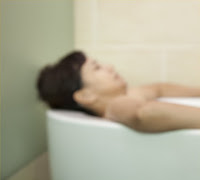LAVENDER:
Twenty years ago every aromatherapy book said that Lavender and Tea Tree oils could be applied
neat (undiluted.) Even the authors who carefully taught proper, skinsafe dilutions for most oils made exceptions for Lavender and Teatree, at least occasionally. Some writers still follow these recommendations.
Over the years many of us heard from friends and colleagues who had become sensitized to either Lavender or Tea Tree from unwise neat use. It was Sylla Shepherd-Hanger, former Safety Chair at NAHA who first identified my Lavender sensitization. I later heard from many, most of them in our beloved industry, also sensitized to this most commonly used essential oil. I also heard from people who were now sensitized to Tea Tree Essential Oil, from usage as innocent as a drop of Tea Tree on a cotton swab applied to a blemish. How many books and bloggers recommend that?
In the past few months, Robert Tisserand, our safety guru, said, despite the research studies that may indicate that Lavender can still be used safely undiluted, that he can no longer recommend undiluted usage of any essential oil.
EUCALYPTUS/PEPPERMINT:
Eucalyptus globulous, Eucalyptus smithii, Eucalyptus radiata and children: Years ago almost everyone recommended the use of the high cineole Eucalyptus oils for use with adults and children with respiratory issues. In fairness, some of the authors in the 90's and the early years of this century did recommend avoiding Eucalyptus globulous, suggesting that either Euc. smithii or Euc. radiata might be gentler and more appropriate for small children.
Then, in the early years of this decade the pendulum swung to the opposite extreme. Absolutely NO high cineole Eucalypts could be used around children under six, or perhaps it was under 12.
Today, we are perhaps approaching more more balanced usage for young children in need of the decongesting effects of the 1.8 cineole rich Eucalyptus oils.
 |
| Robert Tisserand 04 Sept 2015 |
So, again, the pendulum swings closer to center, to balance. Do not use high 1.8 cineole oils like the Eucalyptus species near a child's face, but with proper dilution topical use (think "chest rub") and/or moderate amounts of diffusion are fine.
BATHS:
We have heard reports of people being injured from using essential oils improperly solublized in their bath. So, once again, something we thought we knew has changed.
For years we were told to just add essential oils (6 to 8 drops) to a bath. There were warnings against the strong irritants, and peppermint, but for the benign oils, no problem. And again, problems started to surface. Then were told to add the essential oils to Epsom Salts or other Bath Salts. It sound like a wonderful idea, who doesn't enjoy some soothing bath salts. We even offer a "do it yourself" bath salt kit.
And all at the same time, it appears, several of us thought it through. The salts do seem to absorb the essential oils.. And when added to the tub they seem to dissolve them. But if you think it through, there is nothing in most bath salts that will truly dissolve an essential oil in water, so as the salts dissolve in the water, the essential oils float to the surface, coming into contact with your skin, because we all do know that essential oils do not dissolve in water.
And then there are "Bath Oils"...essential oils dissolved in a liquid carrier oil, to be added to the bath. Beautifully fragrant! But the fixed oil, with its dissolved carrier oil, will not dissolve in your lovely bath, but float on the surface. Because the oils are diluted in a carrier, they are somewhat diluted, so your skin is not contacting undiluted essential oils, but they will not disperse through the water, and they will leave you a slippery tub.
At the AIA conference in Tampa, my teachers from the R. J. Buckle school performed a small experiment in the hotel room, dissolving essential oils in salt, honey cream, polysorbate, and I think, liquid castile. The Salt did not solublize the essential oils. Honey does a respectable but not thorough job. Full fat milk, or better yet, cream dissolves the oils in a bath beautifully. Adding the oils to a spoonful of Liquid Castile works beautifully. Polysorbate 20 not only works beautifully but can sometimes foam a bit, not creating a bubble bath effect, but a bit of foam never hurt.
So, now, I have a "stock bottle" with some of my favorite relaxing essential oils dissolved in Polysorbate by the tub. By preparing in advance they are ready to use when I want them. For me, that has been the safest and most convenient diluent, although I have to admit that I love the feel of either cream or honey added to my bath, if I plan ahead.
Just waiting to see what the *next* thing that we know is true will change.




3 comments:
Hi Marge, seems to be some concern about Polysorbate 20:
https://www.annmariegianni.com/ingredient-watch-list-polysorbate-20-it-may-be-contaminated-with-carcinogenic-14-dioxane/
What do you think?
Thanks!
Jay
So glad to have this knowledge in making DIY products for the bath.
Jay, anything in the known universe COULD conceivably be contaminated. What do I think? you buy your ingredients from known reputable, reliable sources and you stop listening to the fear mongers. Or, you could use a liquid castile soap for your diluent.
Post a Comment